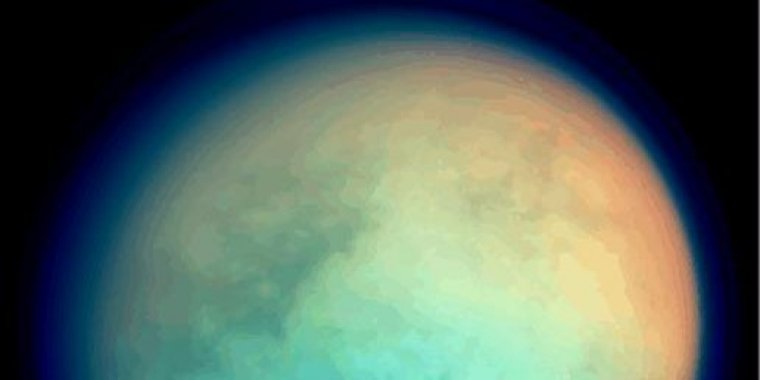| News / Science News |
'Electric Sands' Cover Titan
To build a sandcastle here on Earth, the sand needs to be wet so it can stick together. Not so on Saturn’s strange and largest moon Titan, according to a new study.

Titan in ultraviolet and infrared wavelengths. ![]()
Researchers from the Georgia Institute of Technology say the moon’s non-silicate sand is “electrically charged” and “resistant to motion.” Researchers liken the charge to the static electricity generated when you rub a balloon on your hair.
“If you grabbed piles of grains and built a sand castle on Titan, it would perhaps stay together for weeks due to their electrostatic properties,” said Josef Dufek, the Georgia Tech professor who co-led the study. “Any spacecraft that lands in regions of granular material on Titan is going to have a tough time staying clean. Think of putting a cat in a box of packing peanuts.”
The electrical charge, according to researchers, can last for days or months.
The charge is likely generated by the winds on Titan, which blow at around 30 kilometers per hour. As the sand moves, it begins to hop and collide, becoming charged.
Researchers say the electrification of Titan’s sands could explain why dunes on the moon, some of which are more than 90 meters tall, form in the opposite direction of the prevailing winds.
“These electrostatic forces increase frictional thresholds,” said Josh Mendez Harper, a Georgia Tech geophysics and electrical engineering doctoral student who is the paper’s lead author. “This makes the grains so sticky and cohesive that only heavy winds can move them. The prevailing winds aren’t strong enough to shape the dunes.”
To reach their conclusions, researchers built a model to replicate conditions on Titan. For the model, they put grains of “naphthalene and biphenyl — two toxic, carbon and hydrogen bearing compounds believed to exist on Titan’s surface — into a small cylinder.”
The cylinder was then rotated in a nitrogen environment similar to Titan. Then, they measured the electric characteristics of the grains.
“All of the particles charged well, and about two to five percent didn’t come out of the tumbler,” said Mendez Harper. “They clung to the inside and stuck together. When we did the same experiment with sand and volcanic ash using Earth-like conditions, all of it came out. Nothing stuck.”
Sand on Earth also can pick up an electric charge, but the grains are much smaller and dissipate rapidly.
“These non-silicate, granular materials can hold their electrostatic charges for days, weeks or months at a time under low-gravity conditions,” said George McDonald, a graduate student in the School of Earth and Atmospheric Sciences who also co-authored the paper.
The study was published in the journal Nature Geoscience. (VOA News)
YOU MAY ALSO LIKE





